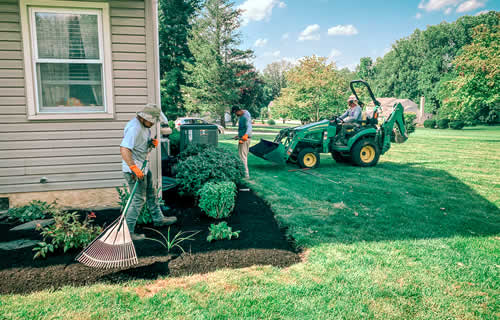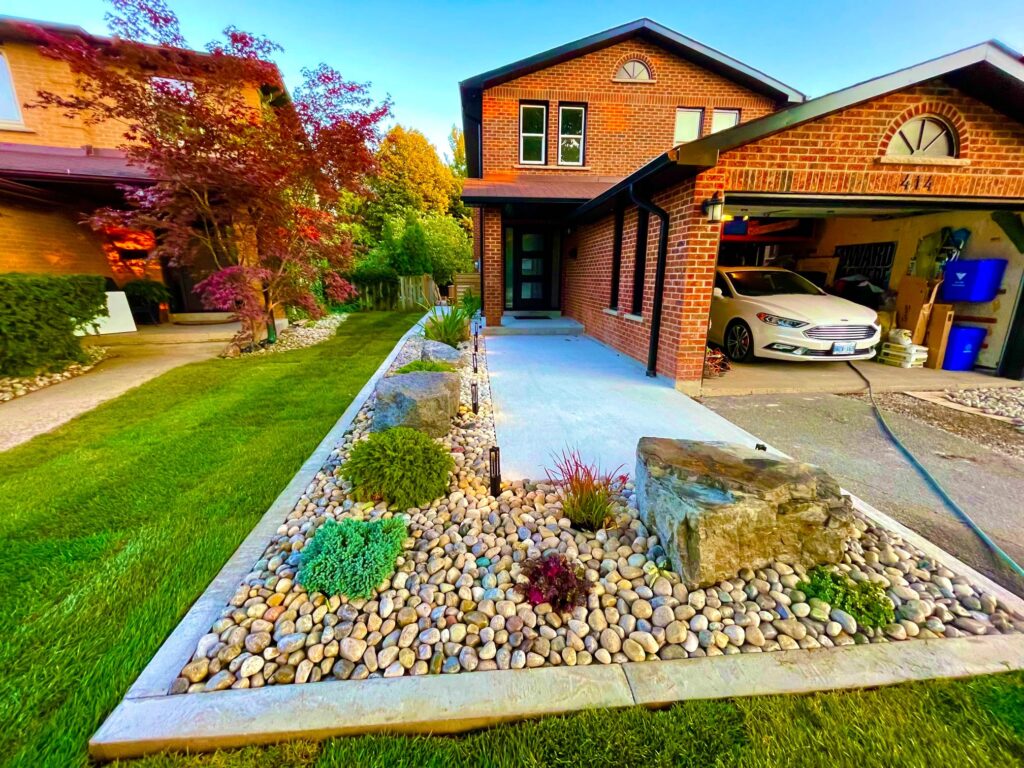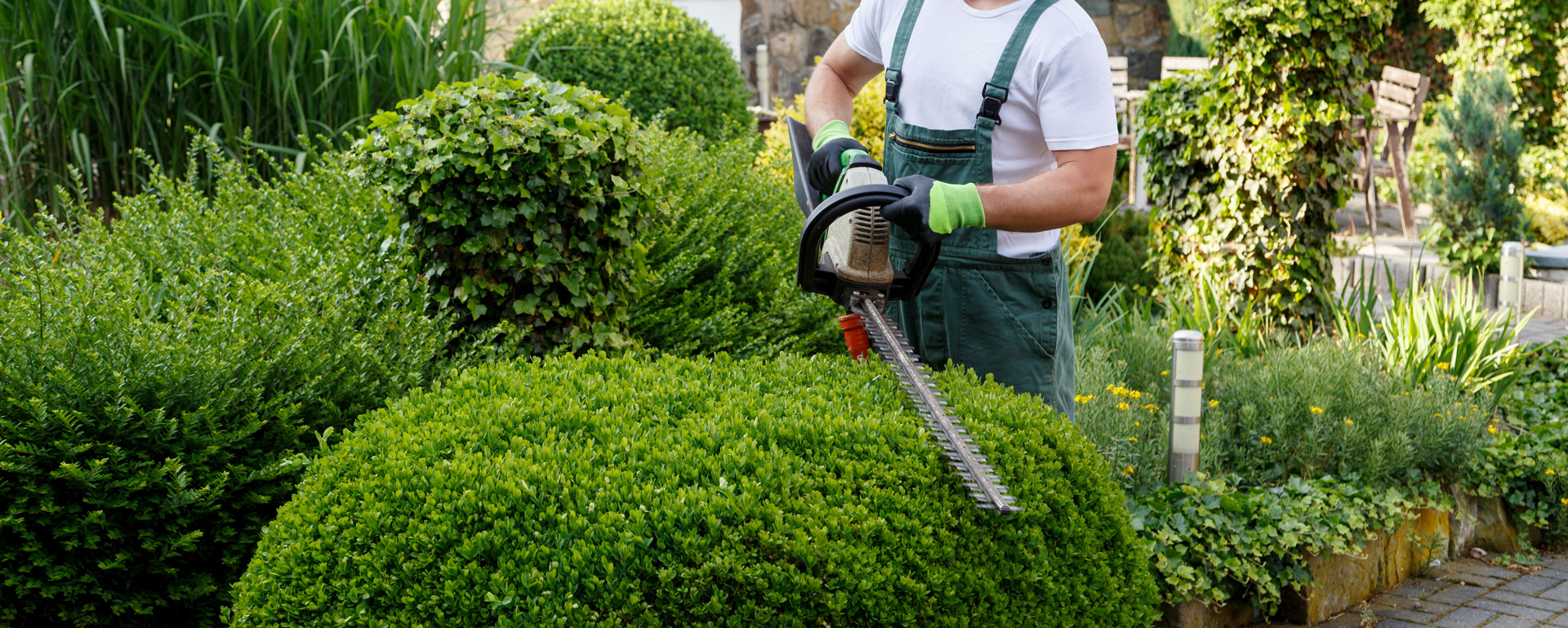Understanding the Comprehensive Range of Functions in Expert Landscape Design Services
The substantial range of professional landscape design services incorporates a variety of essential components - landscaping. It includes landscape design concepts, plant option, and hardscaping features. Furthermore, it resolves irrigation systems and upkeep methods. Each aspect plays a vital duty in creating functional and visually pleasing outside areas. Comprehending just how these parts interact can disclose much regarding the art and scientific research of landscape design. Nonetheless, the trip right into this intricate area is simply starting
Landscape Style Concepts
Efficient landscape style concepts are crucial for creating harmonious outdoor spaces that enhance both aesthetic appeal and functionality (Learn More). These concepts assist the arrangement of components within the landscape, making sure a cohesive aesthetic experience. Secret elements include balance, which distributes aesthetic weight equally; proportion, which relates the size of numerous aspects to each other and the room; and unity, which creates a sense of integrity through constant motifs and products

Plant Option and Installation
In the domain name of specialist landscape design, plant choice and installation play a vital role in achieving a thriving yard. Stressing native plant advantages, seasonal factors to consider, and the certain soil and sunlight needs of each varieties ensures a lasting and cosmetically pleasing landscape. Cautious preparation in these locations not only enhances biodiversity but likewise promotes long-term eco-friendly health.
Native Plant Benefits
Why should house owners consider indigenous plants for their landscaping jobs? Native plants supply many benefits that boost both visual appeals and ecological sustainability. They are well-adapted to regional environments, requiring less water and upkeep compared to non-native types. This resilience minimizes the need for chemical plant foods and chemicals, advertising a healthier ecological community. Furthermore, indigenous plants offer environment and food for local wild animals, including pollinators, which can enhance biodiversity in domestic locations. Their familiarity with regional dirt and weather condition problems additionally results in much better growth prices and longevity. By selecting native plants, homeowners not only produce aesthetically attractive landscapes but also contribute to eco-friendly preservation, making a favorable impact on their regional environment. Consequently, indigenous plants stand for a clever choice for landscaping jobs.
Seasonal Plant Considerations
Property owners that have actually welcomed indigenous plants in their landscape design can better boost their exterior rooms by considering seasonal plant choices. By integrating plants that flourish in particular seasons, they can create dynamic and visually attractive landscapes throughout the year. Springtime might introduce lively flowers like tulips and daffodils, while summer season can showcase lush foliage and vivid perennials. Fall introduces a scheme of cozy tones with goldenrods and asters, while winter months can be emphasized with evergreens and decorative turfs for texture. Expert landscapers typically recommend selecting plants that not just complement existing indigenous varieties yet additionally supply year-round interest and assistance regional wild animals. This thoughtful technique to seasonal plant selection ensures a constantly developing and lasting garden environment.
Dirt and Sunlight Needs
Effective landscaping depends upon comprehending the specific dirt and sunlight demands of plants. Various species grow under varying problems, requiring a mindful assessment of both variables throughout the selection procedure. Dirt types, such as sandy, clay, or fertile, influence drain, nutrient schedule, and root growth. Additionally, pH degrees can influence plant health and wellness, demanding soil testing to ascertain viability. Sunlight requirements differ considerably; some plants grow in complete sun, while others like partial or full shade. A professional landscaper takes into consideration these elements to ensure peak development and aesthetic appeal. By aligning plant options with the setting's specific qualities, landscapes can attain sustainability, strength, and visual consistency, inevitably leading to successful plant establishment and long-lasting upkeep.
Hardscaping Attributes and Construction

While landscape design commonly evokes pictures of lavish greenery and vivid blossoms, hardscaping attributes play a crucial duty in specifying outdoor rooms. These elements, that include patio areas, pathways, keeping wall surfaces, and ornamental stonework, offer framework and functionality to yards and lawns. Hardscaping utilizes products such as concrete, stone, block, and wood, allowing for varied designs that match the natural landscape.
The construction of hardscaping functions requires cautious planning and implementation to guarantee longevity and aesthetic allure. Professionals examine site problems, drainage, and spatial relationships to produce natural outdoor settings. Proper setup strategies are essential, as they prevent concerns like disintegration and shifting gradually.
Including hardscaping not only improves the aesthetic interest of a property however likewise promotes outdoor activities, making it an essential element of detailed landscaping services. Eventually, thoughtful hardscaping adds to both the performance and elegance of exterior spaces.
Irrigation Solutions and Water Monitoring
Reliable watering systems and water administration are important elements of specialist landscape design, as they assure that plants obtain the essential hydration for ideal growth. These systems can vary from simple drip watering configurations to advanced automatic lawn sprinkler, created to satisfy the particular needs of diverse landscapes. Appropriate water monitoring not only optimizes water use, lowering waste, yet likewise improves plant health and lessens illness risks.
Landscaping specialists assess different aspects, consisting of dirt type, plant species, and local environment, to establish tailored watering options. Furthermore, integrating rainwater harvesting methods can even more boost sustainability and performance. Routine upkeep of watering systems is necessary to keep performance and prevent leakages, which can result in water loss and increased prices (Learn More). Eventually, a properly designed watering system plays a pivotal function in protecting the visual allure of outside rooms while advertising ecological stewardship within expert landscape design techniques
Grass Treatment and Upkeep Techniques
Grass treatment and upkeep strategies are fundamental for achieving a lush, healthy yard that enhances the overall landscape. These techniques include different methods focused on promoting excellent growth and visual allure. Normal mowing is essential, as it urges thick, also development while protecting against weeds best site from establishing. Additionally, proper fertilization gives essential nutrients, with applications customized to the certain lawn kind and dirt problems.
Watering methods ought to focus on deep, infrequent watering to motivate origin growth, while oygenation boosts soil structure and advertises vitamins and mineral absorption. Bug and illness management is also crucial; recognizing concerns early permits effective therapies that reduce damage.
Overseeding can rejuvenate broken or thin grass, boosting density and color (landscaping services). By carrying out these targeted lawn treatment techniques, landscape design experts can assure that yards continue to be dynamic and healthy and balanced throughout the seasons, substantially contributing to the total appeal of the building
Seasonal Landscape Care and Upkeep
As the periods change, correct landscape care ends up being vital for keeping the health and appeal of exterior spaces. Each season offers unique difficulties and requirements. In springtime, landscape specialists concentrate on pruning, growing, and feeding to urge growth. Summer needs regular watering, weed control, and insect monitoring to protect newly established plants.

Throughout the year, seasonal landscape maintenance assurances that outside areas stay healthy and aesthetically enticing. Expert services can offer tailored upkeep plans that adapt to the particular needs of each season, enabling homeowner to enjoy dynamic landscapes year-round. In general, seasonal care is a vital facet of specialist landscape design that promotes longevity and aesthetic value.

Sustainable Landscape Design Practices
An expanding number of residential or commercial property proprietors are embracing sustainable landscape design techniques to produce eco-friendly exterior areas. These practices concentrate on conserving sources, improving biodiversity, and minimizing environmental influence. Native plants are typically chosen for their low water requirements and compatibility with local ecosystems, lowering the requirement for chemical plant foods and pesticides. Rainfall yards and absorptive paving are utilized to handle stormwater runoff, advertising groundwater recharge and reducing erosion.
Lasting landscape design incorporates natural gardening techniques that focus on soil health and wellness and advertise natural bug control. Reliable irrigation systems, such as drip irrigation and rainwater harvesting, aid maximize water usage. Furthermore, landscape developers significantly promote for making use of recycled products, such as reclaimed timber and stones, to reduce waste. By adopting these sustainable methods, homeowner not only add to ecological conservation however also develop cosmetically pleasing atmospheres that can love marginal maintenance.
Frequently Asked Questions
Exactly how Lengthy Does a Landscape Design Project Usually Require To Total?
Normally, a landscaping project can take anywhere from a few days to several weeks to complete, depending upon the task's design, dimension, and intricacy needs. Aspects such as climate and resource schedule additionally affect timelines.
What Aspects Impact the Expense of Landscaping Services?
Various variables influence landscape design service costs, including task size, style intricacy, material top quality, labor expenditures, geographic location, and seasonal demand. Each element adds distinctly to the overall economic demands of a landscape design project.
Are Landscape Design Solutions Available Year-Round?
Landscaping services are generally available year-round, although schedule may differ based on area, seasonal climate condition, and specific solution offerings. Some services could be restricted during extreme weather condition or off-peak periods.
Do Landscape Design Firms Offer Service Warranties on Their Job?
Several landscaping business do offer guarantees on their job, which can differ in length and protection. Customers are encouraged to ask about certain terms, ensuring they comprehend what is assured and any problems that apply.
Can I Design My Landscape Without Professional Aid?
Yes, people can create their landscapes without professional aid. However, they may lack competence in plant selection, format, and environmental considerations, possibly resulting in much less efficient designs that might call for costly modifications later on.
In the domain name of specialist landscaping, plant choice and setup play a critical function in accomplishing a growing yard. Homeowners that have actually welcomed indigenous plants in their landscaping can further enhance their outside areas by thinking about seasonal plant choices. Effective landscaping pivots on understanding the specific soil and sunshine demands of plants. Efficient irrigation systems and water administration are important parts of specialist landscaping, as they ensure that plants obtain the essential hydration for suitable growth. Landscaping specialists evaluate numerous aspects, including soil type, plant species, and neighborhood climate, to establish tailored watering options.